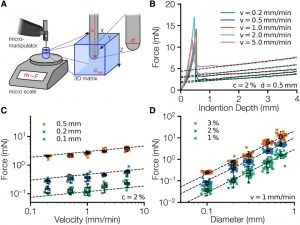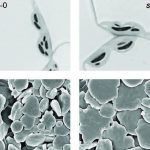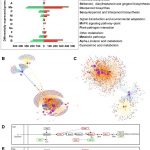Durotropic Growth of Pollen Tubes
Upon germination, the vegetative pollen cell forms a long tubular protrusion, the pollen tube, which rapidly elongates through the pistil and  transports the enclosed immobile sperm cells toward the egg and the central cell for double fertilization. To reach the female gametophyte, growing pollen tubes must penetrate different tissues within the pistil. Flowers of different plant species display a diversity of transmitting tract anatomies, which complicates the investigation of pollen tube guidance. Within the transmitting tract of hollow (sometimes called “open”) styles, as observed for example in Lilium longiflorum flowers, pollen tubes grow on the epidermal surface of a cell-free canal filled with a viscous extracellular matrix. By contrast, the transmitting tract of solid styles, as found in Nicotiana tabacum flowers, is filled with tissue composed of cells embedded in an extracellular matrix, which pollen tubes need to penetrate. Reimann et al. (10.1104/pp.19.01505) show that pollen tubes from Nicotiana tabacum and other plant species with a solid transmitting tract increase their growth rate in response to an increasing matrix stiffness. By contrast, pollen tubes from Lilium longiflorum and other plant species that have hollow transmitting tracts decrease their growth rate with increasing matrix stiffness, even though the forces needed to maintain a constant growth rate remain far below the maximum penetration force these pollen tubes are able to generate. Moreover, when confronted with a transition from a softer to a stiffer matrix, pollen tubes from N. tabacum display a greater ability to penetrate into a stiffer matrix compared with pollen tubes from L. longiflorum. The authors propose the term “durotropism” for the mechanosensory mechanism that guides pollen tubes from plants with solid styles toward stiffer environments, analogous to the term durotaxis that describes the preferential migration of mammalian mesenchymal cells toward regions with higher substrate rigidity. Thus, in those species with solid. solid styles, durotropism may help pollen tubes to navigate through the complex architecture of the pistil to reach the female gametophyte.
transports the enclosed immobile sperm cells toward the egg and the central cell for double fertilization. To reach the female gametophyte, growing pollen tubes must penetrate different tissues within the pistil. Flowers of different plant species display a diversity of transmitting tract anatomies, which complicates the investigation of pollen tube guidance. Within the transmitting tract of hollow (sometimes called “open”) styles, as observed for example in Lilium longiflorum flowers, pollen tubes grow on the epidermal surface of a cell-free canal filled with a viscous extracellular matrix. By contrast, the transmitting tract of solid styles, as found in Nicotiana tabacum flowers, is filled with tissue composed of cells embedded in an extracellular matrix, which pollen tubes need to penetrate. Reimann et al. (10.1104/pp.19.01505) show that pollen tubes from Nicotiana tabacum and other plant species with a solid transmitting tract increase their growth rate in response to an increasing matrix stiffness. By contrast, pollen tubes from Lilium longiflorum and other plant species that have hollow transmitting tracts decrease their growth rate with increasing matrix stiffness, even though the forces needed to maintain a constant growth rate remain far below the maximum penetration force these pollen tubes are able to generate. Moreover, when confronted with a transition from a softer to a stiffer matrix, pollen tubes from N. tabacum display a greater ability to penetrate into a stiffer matrix compared with pollen tubes from L. longiflorum. The authors propose the term “durotropism” for the mechanosensory mechanism that guides pollen tubes from plants with solid styles toward stiffer environments, analogous to the term durotaxis that describes the preferential migration of mammalian mesenchymal cells toward regions with higher substrate rigidity. Thus, in those species with solid. solid styles, durotropism may help pollen tubes to navigate through the complex architecture of the pistil to reach the female gametophyte.



